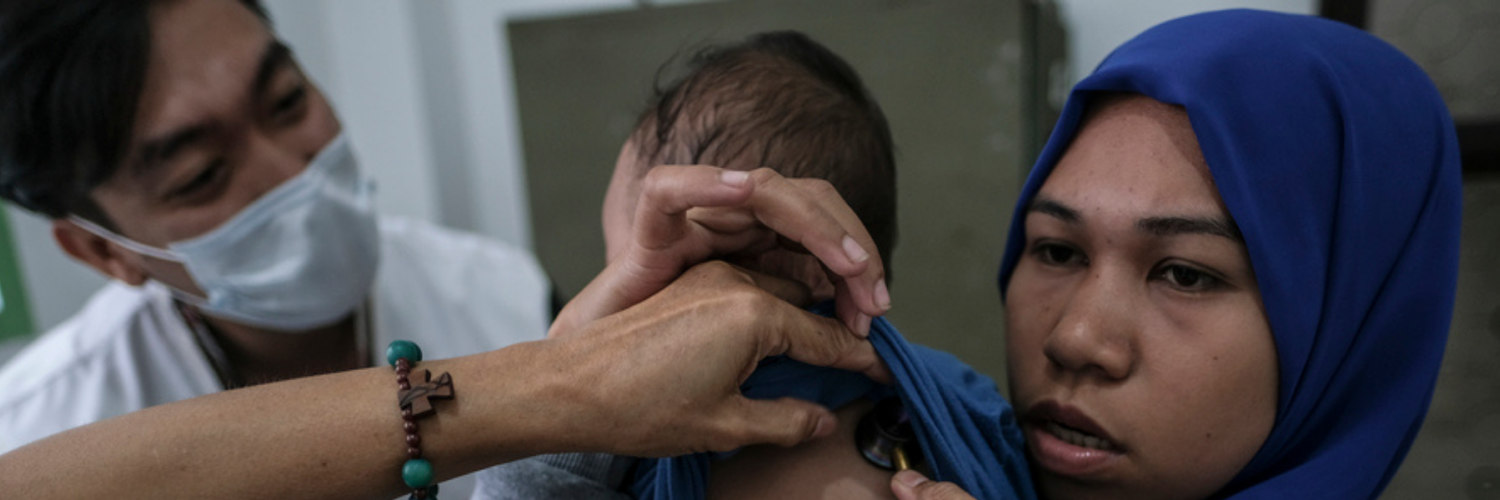Doctors Without Borders/Médecins Sans Frontières (MSF) began operations in the Philippines in 1984. Since then, our work has brought us to Luzon, Visayas and Mindanao, working on tuberculosis, HIV/AIDS, disaster response, and COVID-19.
Timeline: Doctors Without Borders/Médecins Sans Frontières (MSF) in the Philippines
- 1984: Initial projects in the Philippines provided medical aid in response to the health needs brought about by emergencies and natural disasters.
- 1989 to 1995: A tuberculosis control project was launched in Davao City.
- 1992: A Metro Manila project offered medical, psychosocial and socio-legal assistance to street children.
- 1996 to 1999: We launched an STI/HIV/AIDS prevention and control project in Davao City.
- 1998: We provided further support for the health care project for street children, Wat San and pharmacy cooperative projects.
- July 2000: We began providing assistance to populations displaced by the conflict between the Philippine government and the Moro Islamic Liberation Front (MILF).
- 2012: In collaboration with the Department of Health, mobile clinics provided services in typhoon-stricken areas in Cagayan de Oro and Iligan City.
- 2013: MSF provided aid in the aftermath of the Typhoon Haiyan disaster.
- 2015: An agreement was signed with the Department of Health to provide reproductive health services to slum dwellers in Manila.

In Tondo, Manila, Doctors Without Borders worked with a local NGO, Likhaan Center for Women's Health. 2019 © Melanie Wenger
- October 2016: We began working with local partner Likhaan, offering integrated sexual and reproductive health care and services in Manila.
- October 2017: We started providing support to the Department of Health in post-conflict Marawi City.
- 2018: We provided around 18,000 consultations, including more than 12,000 on contraception, medical care for 65 survivors of sexual violence and 1700 ante- and post-natal consultations.
- 2020: Teams supported the contact tracing activities at the community level, and helped implement IPC measures in the health facilities that provide care to COVID-19 patients.
- June to October 2020: We started supporting Manila's San Lazaro Hospital with human resources, PPE, biomed equipment and pharmacy.
- July 2020: A COVID-19 mobile information drive passed health promotion messages to vulnerable populations in Marawi. The team trained many local health teams in charge of COVID-19 surveillance.
- November 2020: Two typhoons hit the Philippines in quick succession. We conducted training on infection prevention and control (IPC) around COVID-19, together with donations of personal protective equipment (PPE) for those in the evacuation centres.
- December 2020: After five years, the activities in Lila Clinic were handed over to Likhaan.
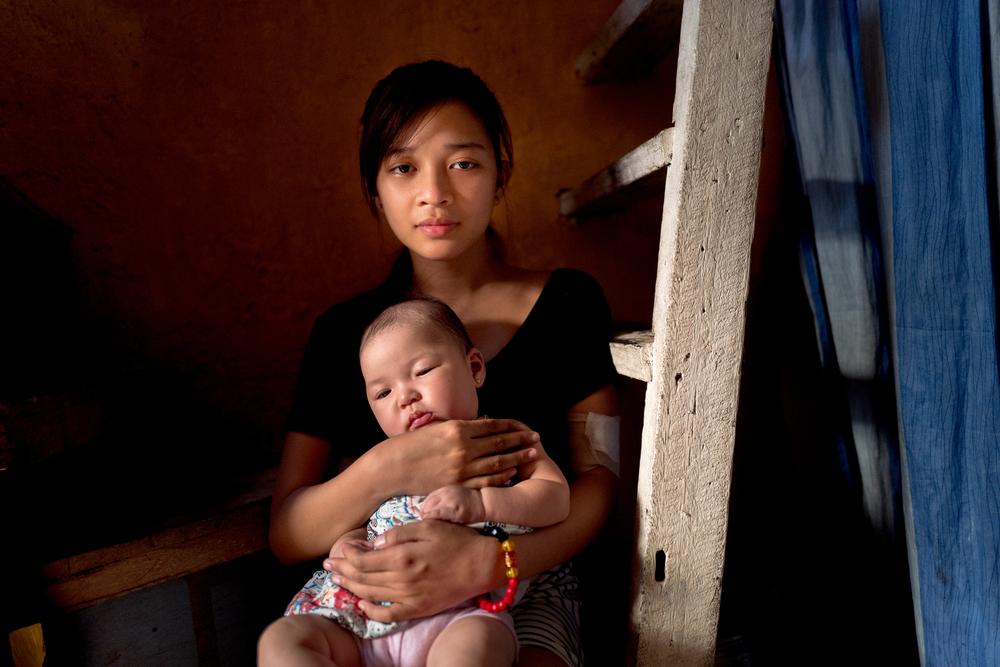
Nicole, 18, teenage mother, and her 3-month-old child in their home in District 121, Tondo, Manila. She had just gotten a contraceptive implant at the Lila Clinic, run by Philippine NGO Likhaan, in partnership with Doctors Without Borders. Philippines, 2019 © Melanie Wenger
-
2021: In partnership with the Manila Health Department, we launched a tuberculosis (TB) project in Tondo, to address challenges in screening and treatment that were exacerbated by the COVID-19 pandemic.
-
January to March 2022: We provided medical and humanitarian assistance to communities on the remote islands of Dinagat, Siargao and other outlying areas, some of the worst affected by Typhoon Rai (local name: Odette).
-
2022: In Tondo, Manila, our TB project expanded its active case-finding activities to include the use of computer-aided diagnostics. To address the stigma and misconceptions around the disease, the project implemented health promotion and education activities. Patients who were confirmed to have TB underwent treatment at government health centers.
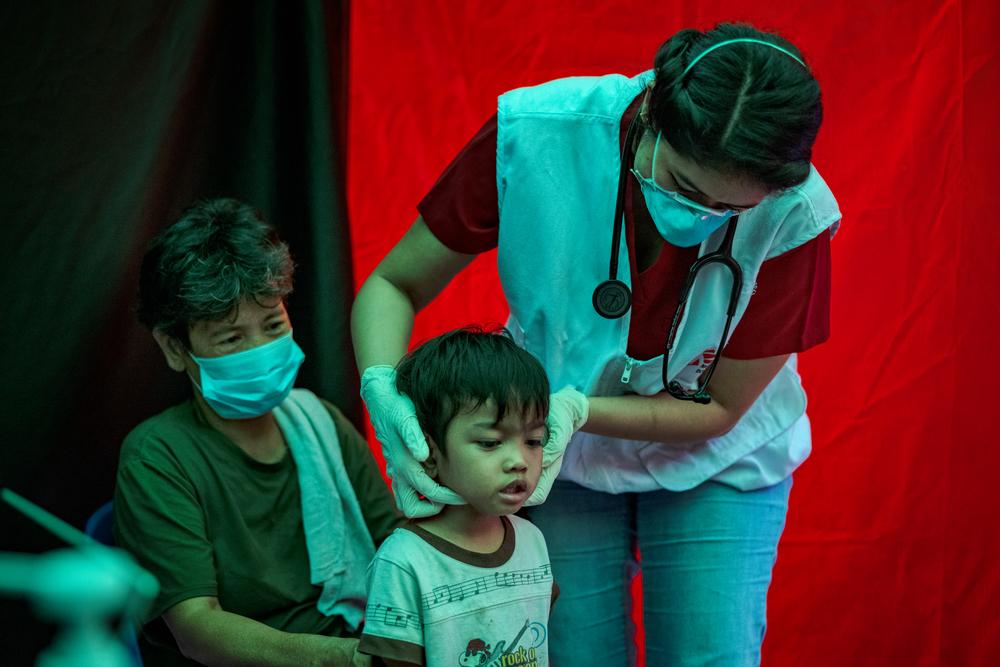
Doctor Trisha Thadhani examines a young boy whose grandmother is confirmed to have TB. March 2023 © Ezra Acayan
Supporting sexual and reproductive health services in the slums of Manila
In 2015, the Philippine government stepped up its efforts to combat cervical cancer, prioritising women in the country’s poorest regions. An assessment by Doctors Without Borders confirmed the need for sexual and reproductive healthcare in the urban slums of Tondo in Manila, the capital city.
In 2016, we launched a partnership with local non-government organisation Likhaan Center for Women's Health, to support a clinic providing screening for cervical cancer and cryotherapy alongside other sexual health and family planning services. Teams provided information on matters of sexual health such as sexually transmitted infections, and gave consultations and free treatment.
Between 2016 and 2020, almost 12,000 women were screened, including 6,400 who were being screened for the first time. With the aid of Manila City Health, the project launched the first round of vaccinations in February 2017. Over 25,000 young girls aged 9 to 13 received the vaccine.
In 2019, the project provided medical aid in the form of 35,600 outpatient consultations and 1,120 antenatal consultations. In addition, teams conducted a total of 15,049 family planning sessions and screened 4,352 women.
For five years, the project supported the populations of San Andres and Tondo, two of the most densely populated and impoverished communities in Manila. By the end of 2020, the activities were handed over to Likhaan.
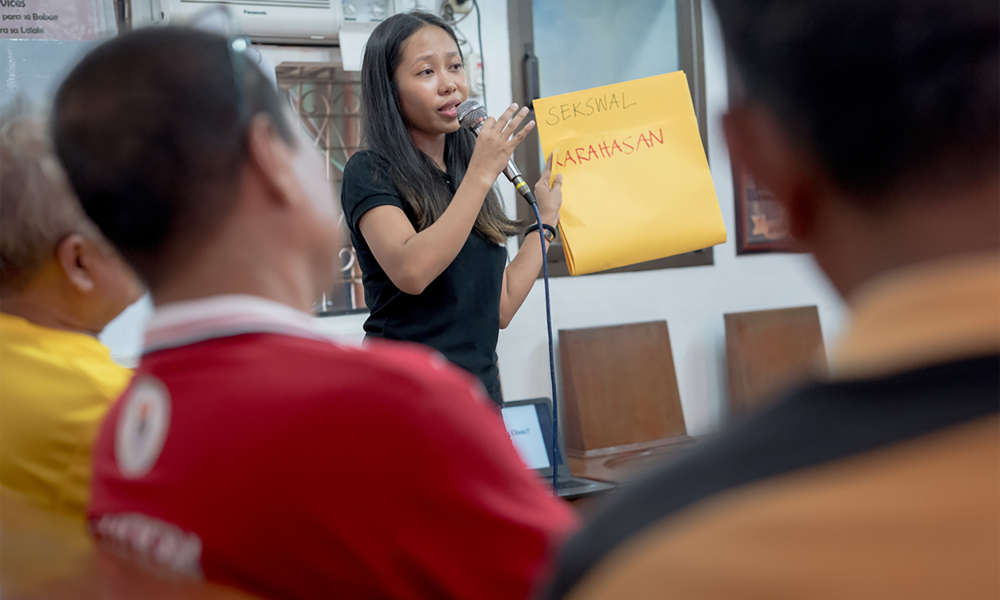
A session on sexual violence care in the Lila Clinic, Manila. © Melanie Wenger
Patient story: Saving invisible lives
"We see them on TV, those who die young because of a cancer in the uterus," Mary Jane explained.
The government stepped up its efforts to beat cervical cancer in rural areas, but Tondo is technically in Manila, the country’s economic hub. Essentially, Mary Jane is invisible.
Mary Jane sent her daughter and her niece to be vaccinated. Since they knew all about the deadly disease, they knew that the immunisation, though daunting, was necessary.
The first time, Mary Jane’s niece said, she was a bit nervous. "I wasn’t looking at the needle. I was looking at my mom."
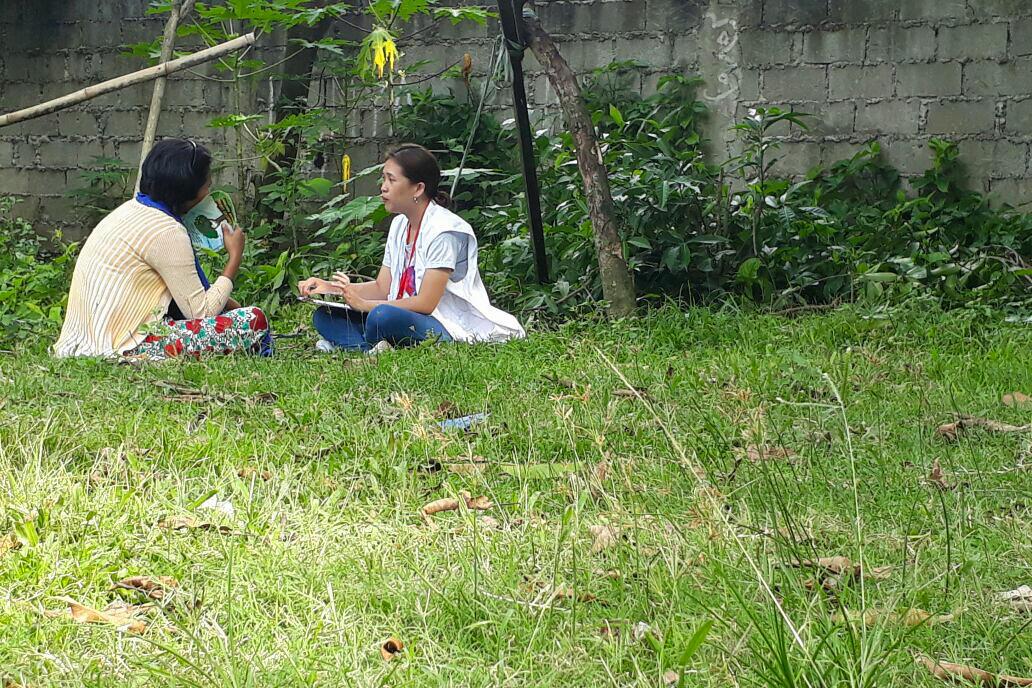
Supporting mental health after the Marawi siege. © MSF
Providing primary healthcare after the Marawi siege
In May 2017, an IS-related group laid siege to the city of Marawi, in the southern part of the country. Conflict erupted between the Philippine army and the group. The siege lasted five months, and around 370,000 locals were forced to flee their homes.
In the aftermath of the siege, Doctors Without Borders made sure the evacuees had access to free and clean water, so they could maintain proper hygiene to prevent any disease outbreaks. Mental health counsellors organised psycho-social activities for those who were coping with the shock of fleeing violence. The stress also affected children, and so play therapy sessions were organized to make them feel like kids again.
Since the end of the siege in October 2017, there have been outbreaks of measles, dengue and polio. Immediately after the siege, teams started to provide medical human resources and supplies in the most populated part of post-conflict Marawi City. Doctors Without Borders cared for 2,300 patients between late October to the end of December 2018.
More than three years later, around 70,000 people continued to live in harsh conditions in temporary shelters, and another 50,000 are estimated to be living in other family members’ houses.
The project was closed in 2022, with activities handed over to the city health offices and health centres

Primary healthcare in Marawi. © Veejay Villafranca/MSF
- Sobaida Comadug, 60
Sobaida Comadug, 60, has spent all her life in Marawi. She describes the daily challenges they face: water is lacking; temporary shelters are far from the markets; food is costly. All these factors push people to eat ready-to-eat meals, while doctors recommend healthy food to complement treatment for non-communicable diseases.
"It is more difficult to cook healthy meals. We are far from the fruit and vegetable vendors, and even if we could reach them, we don't have clean water to wash them," says Sobaida.
Patient story: Displaced
What is life like in a temporary shelter?

A health worker treats a paediatric patient. © MSF
Medical teams arrive one day after Typhoon Haiyan
In 2013, Typhoon Haiyan—one of the strongest super typhoons ever recorded—caused over 6,300 confirmed deaths and displaced four million people in the Philippines. Essential infrastructure were damaged or destroyed, and emergency supplies swept away. The medical needs were immense, and the risk for communicable disease outbreaks was high.
Doctors Without Borders/Médecins Sans Frontières was able to dispatch teams to the affected areas within a day of the super typhoon making landfall.
Relief efforts included 11,624 surgical interventions; 29,188 vaccinations for tetanus, measles, polio and hepatitis; 27,044 mental healthcare and/or counselling sessions; 2,445 babies delivered; mobile clinics in 133 different locations; the construction of one semi-permanent hospital; seven hospitals rehabilitated; distribution of 71,979 relief kits; food packs for 50,000 people; and distribution of 14,473,500 litres of water.
In total, we sent 1,855 tonnes of cargo and deployed almost 800 relief workers to the country.
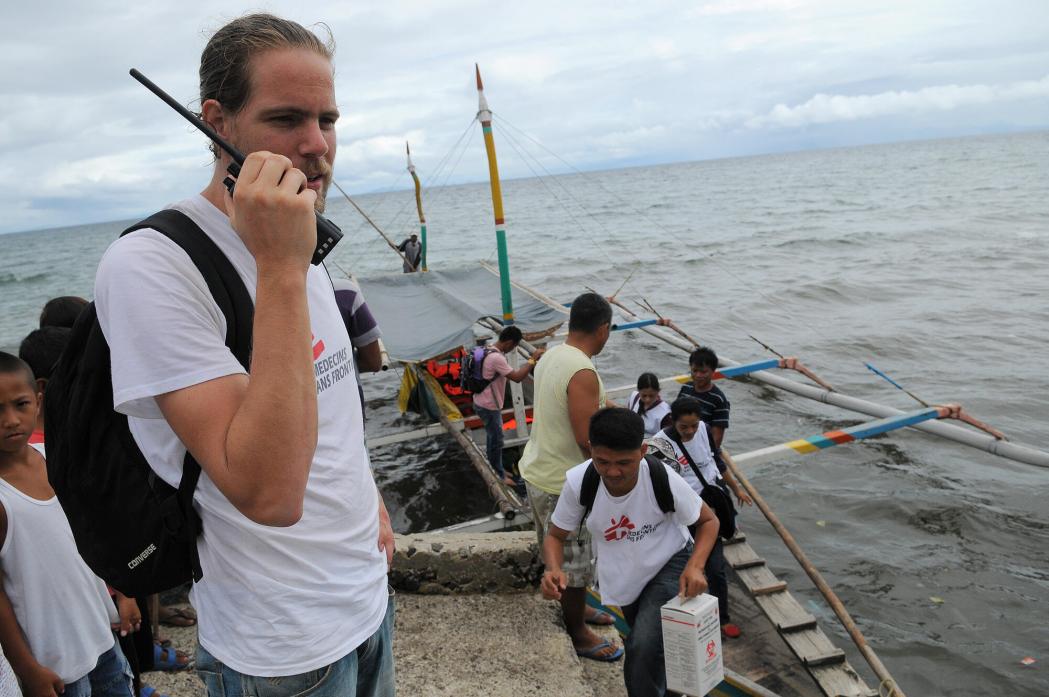
Bringing services and supplies to distant towns. © MSF
- Patient stories: Losing everything
"When the typhoon made landfall in our town, we sought refuge in my parents’ house,” said the mother of five-month-old Niño Padernos. "The wind was so strong that it blew off the roof of the house. Niño was soaked in water. We cannot wrap him or dry him as all our things are wet. We have nothing, we lost everything."
More than a week after the storm, Niño and his family lived in a makeshift house made of broken wood from the remnants of their destroyed home.
"Two days ago he came down with a fever. It didn’t go away," said Niño’s mother. "I am very worried. There is no free health centre near our town; it was destroyed. We asked where we could bring our son. We have no money for his treatment and he is our only child. The community told us to come here to Guiuan. They said MSF gives free care and could help us." They travelled from Buabua town, one and a half hours away by motorbike from Guiuan town.
Niño was admitted to the MSF tented hospital in Guiuan, where he was treated.
- Stories from the field: After the storm
Ten days after the typhoon struck, Emergency Coordinator Caroline Seguin described the huge logistical challenges of transporting emergency aid.
"We’ve managed to bring more than 150 staff and hundreds of tonnes of supplies into the country. The healthcare needs are significant, especially since the living conditions exacerbate the risk of respiratory tract infections, pneumonia and waterborne diseases. In most places where we work, the health systems have been severely disrupted and we’re focusing on restoring quality primary healthcare and hospital services. In Guiuan, a tent hospital has been put up on the premises of the damaged hospital. In Tacloban, an inflatable hospital will be set up and will provide all services including emergency room, inpatient department, and operating theatre. Our teams will urgently set up maternity, obstetrics and gynaecology units. The need for mental health services is overwhelming. It’s an extremely important aspect of our response, and quite straightforward to implement compared with other more logistically challenging services."
The aftermath of Haiyan
Typhoon Haiyan wreaked havoc in Guiuan, a town of around 45,000 people in eastern Samar island.
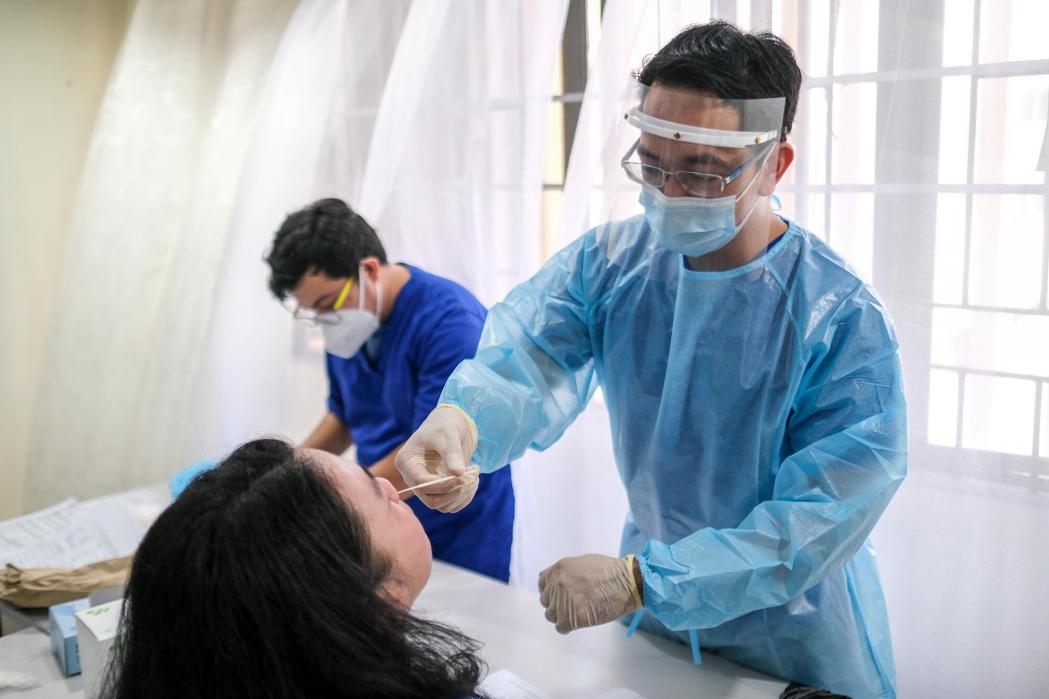
Staff get swabbed for COVID-19 after their deployment at San Lazaro Hospital. © Veejay Villafranca/MSF
COVID-19 Response
Supporting San Lazaro Hospital
In January 2020, the first case of COVID-19 in the country was treated at San Lazaro Hospital (SLH), a Special National Hospital Medical Centre for Infectious Diseases in Manila.
SLH initially had two COVID-19 Intensive Care Units and three wards. Doctors Without Borders/Médecins Sans Frontières boosted SLH’s testing, data management, and case management capacity, with biomedical equipment, medical supplies, personal protective equipment, training for infection prevention and control, and infrastructure improvements.
We also supported SLH with human resources to assist at the Departments of Laboratory and Epidemiology, and doctors and nurses to assist in the COVID-19 wards and triage, and the tuberculosis ward.
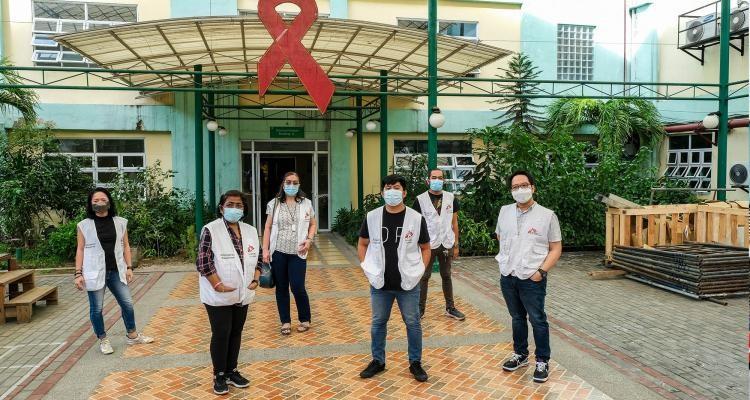
© Veejay Villafranca/MSF
Protecting from the virus in the slums
It was difficult to protect from the pandemic in the densely populated urban poor communities of Manila, where a single barangay (the smallest administrative unit of governance in the Philippines) has a population of 55,000 to 61,000.
For a brief period in 2020, home isolation was permitted by the government. In the slums of Tondo, we supported households and their close contacts with over 2,000 hygiene kits. Since those in quarantine could not work, we collaborated with a local congregation to provide food packs as needed. Those in quarantine also received mental health and psychosocial support.
In the barangay health centers, we contributed to improving infection prevention and control (IPC) measures, through training, the provision of personal protective equipment, handwashing stations, cleaning supplies, and educational material on the virus. We also assisted with contact tracing.
To help protect barangay health emergency response staff, we provided IPC supply: face masks, face shields, alcohol and hand soap. The movement also produced risk communication video materials.
- Stories from the field: The challenge of isolating in the slums
Home isolation was a challenge in such small households. Social worker Lyka Lucena shared, "Home isolation is very difficult – almost impossible – for those living in the slums. It is rare to find a separate room for the patient. Many were struggling to meet basic needs due to economic concerns such as sudden unemployment and loss of income source for those in the informal economy."
Mental health issues made things even more difficult. "Many who were in home quarantine were experiencing anxiety and depressed emotions. They were worried about infecting others especially their loved ones. They were also scared of getting sick or getting the virus again. A lot of patients experienced loneliness due to being away from their families. Many shared feelings of anger, frustration, and helplessness about their situation."
- Patient stories: Beyond medicine and masks
Often, healthcare workers provide more than just medication and procedures. Nurse Rhomina Suan shared, “When this patient was admitted, she was very worried for her kids. Upon admission, the only symptoms she had was a fever and sore throat. Her swab test, even after a week of hospitalisation, remained positive. A few days later, her oxygen saturation declined, requiring the use of a Non-Rebreather Mask (NRM). We started her with another dose of antibiotics. She became more anxious, frustrated even.”
“She always recognised my voice when I entered her room. She always said, ‘Mina, you’re very cheerful, aren’t you?’ I responded, ‘Of course, ma’am, I want you to be as energetic as I am! Just remember, we want your oxygen levels to go up, so we can remove the NRM.’"
The patient improved soon after and was discharged a few days later.
COVID-19 Response: Isolation, medicine and masks
How do you respond to COVID-19 in a crowded urban center like Manila? From the hospital to the slums, Doctors Without Borders provided support.
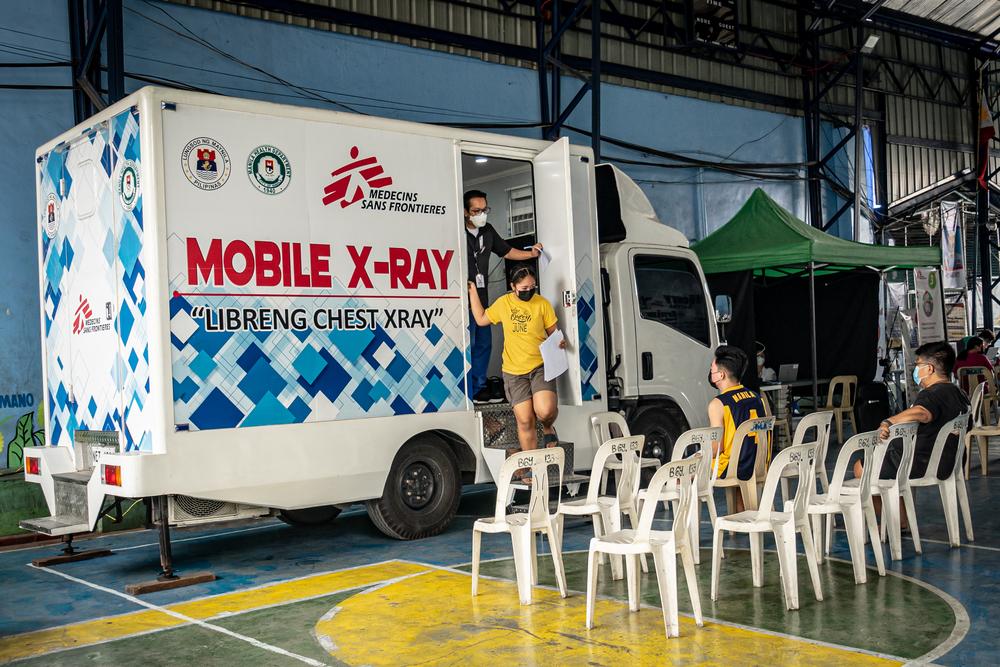
Doctors Without Borders takes this truck to different barangays (communities) around Tondo, Manila, to offer free x-rays to the residents. March, 2023 © Ria Kristina Torrente
Tackling tuberculosis in Tondo
In partnership with the Manila Health Department, we launched a tuberculosis (TB) project in Tondo, to address challenges in screening and treatment that were exacerbated by the COVID-19 pandemic. A key element of the project is a mobile x-ray truck for chest x-rays, which we bring to different communities in our search for those with active TB, referring patients to local health centres for treatment. Finding active cases of TB also means conducting home visits immediately after diagnosis, to screen patients’ households and close contacts, and to offer preventive TB treatment to children.
In 2022, our TB project expanded its active case-finding activities to include the use of computer-aided diagnostics. To address the stigma and misconceptions around the disease, the project implemented health promotion and education activities. Patients who were confirmed to have TB underwent treatment at government health centers, and received regular support and counseling from our teams.
Beyond the borders of the archipelago
We have many field workers and staff from the Philippines, working in emergencies, missions and projects around the world.
In Lebanon, Filipina anesthetist Karina Aguilar talks about her work in a hospital in Bar Elias.
What is a Filipino Finance Coordinator doing in Yemen? Read Melvin Kaibigan's story.
